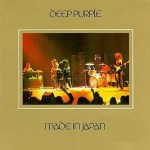More of the Music of Deep Purple
Reviews and Commentaries for Made In Japan
To our dismay, we discovered that some of the stampers for some of the sides on some of the British import pressings are actually sourced from a well known American cutting house. When those sides did poorly in the shootout, naturally we wanted to know more about them in order to avoid buying any more pressings with those markings.
We had no idea the British would “import” the metalwork from here, but they did, and the results were not good, at least not for us audiophiles. I hope it goes without saying that we will not be selling any versions of the album that are not cut in England.
This is what you learn when you have lots of copies of the same album and play them against each other.
We constantly Experiment with Different Record Pressings this way and we recommend you do the same.
Carry out as many experiments as you can find time for. The quality of your collection — at least the sonic quality of your collection — will improve immensely.
The Best UK Pressings Rock
The best sides tended to have the same qualities. They were huge, open, clear, transparent, rich, tubey and natural.
And of course they rocked, with startling dynamics, massive amounts of bass and a full-bodied midrange. The better the pressing the more the instruments jumped right out of the speakers. Live in your listening room was the sound we were after, and this copy delivered it!
What We’re Listening For on Made in Japan
- Energy for starters. What could be more important than the life of the music?
- Then: presence and immediacy. The vocals aren’t “back there” somewhere, lost in the mix. They’re front and center where any recording engineer worth his salt — Martin Birch in this case — would have put them.
- The Big Sound comes next — wall to wall, lots of depth, huge space, three-dimensionality, all that sort of thing.
- Then transient information — fast, clear, sharp attacks, not the smear and thickness so common to these LPs.
- Tight punchy bass — which ties in with good transient information, also the issue of frequency extension further down.
- Next: transparency — the quality that allows you to hear deep into the soundfield, showing you the space and air around all the instruments.
- Extend the top and bottom and voila, you have The Real Thing — an honest to goodness Hot Stamper.
